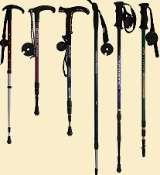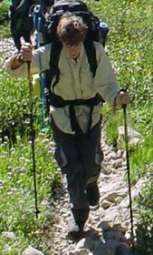
Hiking Poles
Sticks, Staffs, or Poles?
 Hiking sticks and hiking staffs are the same thing - a long, wooden limb carried while hiking and used for many purposes, primarily to aid in hiking up and down trails. Hiking poles are new, hi-tech gadgets that look like ski poles but have a wide range of features and prices. Let's check 'em out.
Hiking sticks and hiking staffs are the same thing - a long, wooden limb carried while hiking and used for many purposes, primarily to aid in hiking up and down trails. Hiking poles are new, hi-tech gadgets that look like ski poles but have a wide range of features and prices. Let's check 'em out.
Pros and Cons
 There are many benefits to using aids for hiking and some drawbacks:
There are many benefits to using aids for hiking and some drawbacks:
- Increase Endurance - using poles offloads some of the work from your legs to your arms. This spreads out the work and lets you hike longer.
- Climb Hills Better - on steeper grades, the benefit of using poles increases. Your legs work significantly less.
- Better Balance - like outriggers on a canoe, you can navigate rough or loose ground more safely.
- Reduce Knee Stress - the lighter load on your legs may result in less knee trouble. But, knee problems should be checked by a doctor too.
- Increased Workload - poles spread the workload to more muscles but they also increase the amount of work done. Your legs may not be as tired, but your whole body will need to work harder.
- Poor Technique - unless you learn to use your poles correctly, you won't achieve any of the benefits and they will just be a burden.
Hiking Sticks
I've used hiking sticks since I started hiking with my dad. As a kid, its natural to pick up a stick and throw it or hit your brother with it. When you find one that just feels right, you hang onto it and start using it to help your way up the steeper stretches. That's how I started using sticks. And, that is how I still get hiking sticks - I pick them up on the path.
Pretty much every multi-day hike I go on, I'll find a stick and then start carving on it whenever there's a resting point. On this page, you can see a couple of the sticks I've carved on. These are from boy scout camping and youth group trips. It's fun, gives the kids something to talk to me about, and keeps me out of trouble. Not to mention the benefits of having a good, sturdy hiking stick to help with the trek. I actually use the sticks too.
 Here are some of the uses for hiking sticks:
Here are some of the uses for hiking sticks:
- Someplace to keep hands elevated so they don't swell
- Extra lift when climbing steep trails
- Extra support when descending steep trails
- Balance - through boulder fields, crossing streams, narrow ledges, slippery mud (but watch out that you don't break it between big rocks)
- Replacement tent pole
- Knocking spider webs down ahead of you on the trail
- Protection against snakes, dogs, and other bothers
- Longer reach - things dropped in water, lifting bearbags, frisbees in trees, helping companions across streams and logs
- Resting Aid to lean on
- Signal for help by tying on a bandanna and waving
- Noise-maker - tap it on rocks as you hike to let wildlife know you are coming
- Monopod - steady your camera or GPS or compass
- Trail tool to knock branches, rocks, pine cones off to the side of the trail
Consider these features when choosing your wild hiking stick or buying one:
- About shoulder high so you can lean on it or rest your chin on it
- Straight, not gnarly or crooked, so it will support your weight
- Thin, but sturdy, so it weighs as little as possible
- Solid, with few knots or cracks so it can be whittled
Hiking Poles
 I think the reason I like hiking sticks so much is because they are a free, natural thing that makes my time in the wild more enjoyable. When I carve on my stick, it also becomes a reminder of the outing, sort of like taking pictures. But, probably the reason I like hiking sticks better than hiking poles is the free part. :-) I'm kinda cheap and hiking poles are definitely not cheap. They are tools for a niche market which means they can be pricey.
I think the reason I like hiking sticks so much is because they are a free, natural thing that makes my time in the wild more enjoyable. When I carve on my stick, it also becomes a reminder of the outing, sort of like taking pictures. But, probably the reason I like hiking sticks better than hiking poles is the free part. :-) I'm kinda cheap and hiking poles are definitely not cheap. They are tools for a niche market which means they can be pricey.
Hiking poles are useful much like hiking sticks, except that they are shorter, lighter, and metal. This means they are not as good at supporting your full weight. Other than that, you can do pretty much the same things with them as with a stick.
Hiking poles have some features not found in hiking sticks:
- Shock absorbing mechanisms - small springs that absorb some of the thunk of hitting the ground. Over a long, rough hike you may notice the difference.
- Rubber grips - more comfortable handling. The grip should encompass the top of the pole so you can grip it with your palm.
- Extendable lengths - many poles are made in 2 or 3 parts that telescope. Easier for packing and adjustable for other hikers or other uses. You can shorten the poles when climbing and lengthen when descending to maintain good balance. Make darn sure you have locked the pieces in place before starting out again.
- Baskets - a small basket near the tip to minimize sinking into mud or snow.
Using Hiking Poles
 Your pole should be about 3 inches shorter than your armpit. That is a good general length that will work for most uphill, downhill, and flat terrain and keep you from adjusting the lengths during hikes.
Your pole should be about 3 inches shorter than your armpit. That is a good general length that will work for most uphill, downhill, and flat terrain and keep you from adjusting the lengths during hikes.
When you hold your poles, use the wrist straps. Put your hand through the strap and then make a U or O with your thumb and fingers around the grip section. You should not need to tightly grip the pole but instead use your rist to put a load on the pole. Where you are holding the pole, it should swing freely sort of like an extra joint connecting the pole to your arm.
When hiking on fairly Level Ground, the poles are swung forward in time with the opposite foot. But, the pole tips never come ahead of the body. You just plant the tip and push down with your wrist to provide more forward power.
On Steep Upgrades, the poles are planted next to or slightly ahead of the same foot. Pushing down on the wrist strap lightens the load on that same leg. Your hands tend to be higher up around shoulder height when climbing.
On Steep Downgrades, poles are planted just a bit before the same foot. This provides stability for placing your foot and prevents twists and slips. Pushing down on the pole reduces the shock to the knee and leg when it lands. Your hands tend to be more at waist level when navigating steep downhill sections.
The Great Debate
Some die-hard old hikers still regard those that use hiking poles as
[insert derogatory term here] and they always will. Here I am, having hiked with a stick for years and I find no need to switch. I know that I will start using hiking poles one day.
It will happen like this: one of my relatives will see them in the L.L. Bean catalog and know I don't have any and buy them for me for Christmas. Then, I'll have to try them. Then, I'll find out how great they are and I'll be writing a page about how I don't understand how I could have ever gotten along without them.
But, until that day happens, I'll stick to my stick and struggle along. I completely understand that a wooden hiking stick is heavier and can be more of a burden than an aid. But, I use one more for the feeling of having it than the need for it - my knees are strong, my legs don't get too tired, and I usually hike with people slower than myself. The help in balancing when crossing logs and rivers is when I get the most benefit from it.
UPDATE: I did get a set of inexpensive, light-weight hiking poles from my sons for Christmas. On my long hikes, they have been a HUGE help. For going up and down steep trail, they really make a big difference, and I use them to set up my shelter too.
For those of you wanting to extend your hiking abilities and have a more efficient hike, definitely check out hiking poles. Once you get used to using them, they will be a big benefit in your hiking. Here is my son and a friend using hiking poles to climb a steep trail and cross a stream in Wyoming.


All Comments:
Mar 07, 2012 - Claire Isabelle Poirier
Aug 11, 2012 - trail2nowhere
Sep 16, 2013 - melensdad
Sep 08, 2015 - Lory
:) enjoyed your sincere commentaries. lk
I think I'm human (secret code below...ha)
Sep 09, 2015 - doghiker
Dec 30, 2015 - K
Aug 18, 2016 - chris
Aug 18, 2016 - Hiking Dude
They collapse to 25 inches, and I've used them between me and snakes, dogs, brush, spider webs across the trail. When collapsed, they get strapped to my pack just fine.
I'm curious about your animal attack stories - care to share more?
Hike On
Sep 26, 2016 - Wolf
Ask a Question
Find more Hiking Resources at www.HikingDude.com


 Contemplating Umbrellas
Contemplating Umbrellas Determining Water Needs
Determining Water Needs
Follow Me
Recent Comments